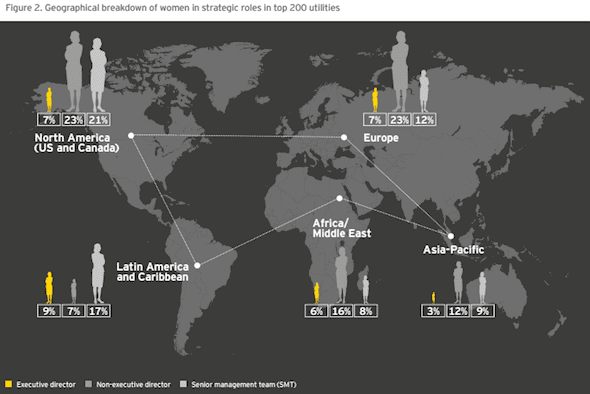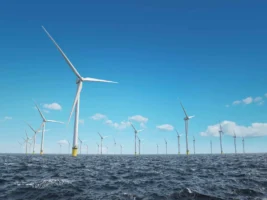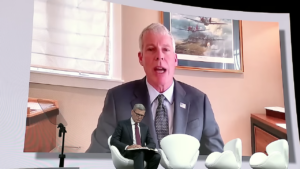Is a lack of gender diversity holding back Australia’s energy revolution? On this International Women’s Day, the fact that the executive ranks of the nation’s energy industry remains heavily populated by “ageing white male engineers” is worth renewed consideration. But don’t take our word for it. A study released on Monday by Ernst & Young has confirmed this is still a serious problem, not just in Australia but around the globe.
EY’s 2016 Women in Power and Utilities Index is an analysis of the number of men and women on the board of directors, and in the senior management teams, of the top 200 utilities by revenue across the globe.
The first and most glaring statistic it reveals is that, globally, women hold just 16 per cent of board positions in the sector – a worryingly small number that, according to the report, has increased by a “painfully small” 1 per cent since 2014.
At this rate, the report notes, “it would take as long as 42 years to reach 30 per cent women on boards, and 72 years to reach 40 per cent. That’s too long.”
Indeed it is. We can only hope that the progress of women in the industry follows a trajectory more along the lines of solar technology, with a critical turning point arriving soon.
This brings us to the second interesting statistic in the EY report: that the top 20 most gender-diverse utilities – and EnergyAustralia is among these, at number five – outperformed the least gender diverse by 14.8 per cent on ROE (ratio of net profit to shareholders’ equity).
This is no great revelation – and it’s certainly not exclusive to the energy industry. In 2012, the World Development Report noted that “greater gender equality is smart economics, enhancing productivity, advancing development outcomes for the next generation, and making institutions more representative.”
But according to Matt Rennie, EY Oceania Power & Utilities Leader, it is even more strikingly evident in the energy industry, which now more than ever needs the innovative ideas and fresh thinking that diversity brings.
“If I look at what’s going on with the electricity sector in general, the retailers are struggling with the future of their business models; networks are struggling with what battery storage and solar are going to do. And they’re both struggling with what their role will be in the future energy market,” Rennie told RenewEconomy in an interview on Tuesday.
“The thing about about utilities, is we like doing today what we did yesterday. And that doesn’t really allow for diversity of talent or of ideas.
“When you’ve got such a transformative event coming,” Rennie says, pointing to the unstoppable shift away from centralised fossil fuel energy generation to distributed renewable energy technologies. “It just adds to the need for diversity.”
And here’s how a recent Huffington Post analysis put it: “Women are an underutilised resource in both climate change adaptation and mitigation initiatives. With the proper capacity, women have the capability to represent key energy managers, contributors and beneficiaries of renewable energy and efficiency projects. Failure of nations to recognise the full potential of women will result in lost opportunities to achieve multiple benefits across the energy sector.”
The Clean Energy Council also recognises this, and has today announced AllGrid Energy Marketing and Alliance Manager Deborah Oberon as recipient of its inaugural Developing Women Directors Scholarship.
The scholarship is just one of the ways the CEC hopes to address what it describes as an imbalance in the industry that sees men “far outnumber women in all areas.”
“Gender diversity is an important issue, and as the peak body for the renewable energy industry it’s important that the Clean Energy Council develops and leads initiatives such as this to maximise opportunities for professional women in our sector,” CEC chief Kane Thornton said when the scholarship was first announced.
“There are no quick fixes and this is a complicated issue, but we are committed to a range of initiatives to address the imbalance,” Thornton said
As Rennie puts it, “any form of diversity of thought and strategy is going to be useful; anything that challenges the status quo.”
Australia, he adds, simply can’t afford to not do anything about this – and here he is talking about both the coming disruptive energy models, and putting more women in positions to help manage the massive transition.
So how can this be done? The EY report outlines three steps that executives can take immediately:
– Sponsor future female leaders and encourage other senior leaders — male and female — to do the same. If you’re not aware of promising women in the pipeline, seek them out;
– Make your culture more inclusive. Offer real workplace flexibility, consider how to recruit more women into operational roles, tackle unconscious bias and measure gender diversity;
– Look at your entire talent pipeline. Build a culture of support at all levels, especially in recruitment and performance management in those early years.
A look at the report’s Top 20 list for gender diversity, we can see some of this in action.
At numb er 3, for example, is French energy giant, Engie. As the owner of some of Australia’s dirtiest coal power plants – including Hazelwood in Victoria – Engie has some heavy lifting to do in the transition to renewables. And as the report shows it has been putting more women in top jobs at the company, including at the uppermost level, where Isabelle Kocher is replacing Gerard Mestrallet as CEO. More recently, it appointed four women as non-executive directors: Marie-Jose Nadeau, Barbara Kux, Catherine Guillouard and Mari-Noëlle Jégo-Laveissière.
er 3, for example, is French energy giant, Engie. As the owner of some of Australia’s dirtiest coal power plants – including Hazelwood in Victoria – Engie has some heavy lifting to do in the transition to renewables. And as the report shows it has been putting more women in top jobs at the company, including at the uppermost level, where Isabelle Kocher is replacing Gerard Mestrallet as CEO. More recently, it appointed four women as non-executive directors: Marie-Jose Nadeau, Barbara Kux, Catherine Guillouard and Mari-Noëlle Jégo-Laveissière.
How much these changes in the executive ranks have had to do with Engie’s recently launched three-year strategy to fast-track its transition to global clean energy leader, and dump its carbon-risk exposed coal and gas assets, is impossible to measure. But it gels with what the analysis says.
And finally we have our own EnergyAustralia, which moved to the number 5 spot, no doubt boosted by the 2014 appointment of Catherine Tanna as the company’s CEO/managing director. Tanna – whose experience in the energy sector had been centred around gas and oil, with roles at BG Group, BHP Billiton and Royal Dutch Shell – took the reins from Richard McIndoe, who announced his retirement in December 2013, after eight years in the role.
At this year’s interim results announcement, Tanna said the company was working on a “realistic approach” to the “unprecedented” decline in power demand, over-capacity in electricity generation and declining wholesale power prices. And she said EA would focus on “realigning the business with the new market and political paradigms.”
“Demand for centralised generation has dropped, and I think all customers want a cleaner energy supply,” Tanna said. “We have to find an industry-led, government supported solution for modernising generation in Australia, and that requires orderly, managed retirement of the oldest plants in the fleet.
“This would have the double benefit of making space for renewables, so if you have a situation where supply exceeds demand, you need to retire the older fleet to make way for renewables,” she said.
“Industry has to lead. I think it would be a mistake to sit around and wait for a plan; industry should go to governments and say this is what we need.”










